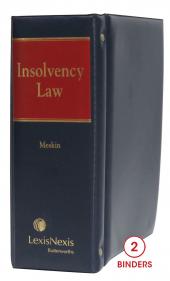South African Business Rescue Procedure
This publication sets out the law applicable to business rescue procedures in South Africa.
One Year Subscription Only Terms
Subscribers receive the product(s) listed on the Order Form and any Updates made available during the annual subscription period. Shipping and handling fees are not included in the annual price.
Subscribers are advised of the number of Updates that were made to the particular publication the prior year. The number of Updates may vary due to developments in the law and other publishing issues, but subscribers may use this as a rough estimate of future shipments. Subscribers may call Customer Support at 800-833-9844 for additional information.
Subscribers may cancel this subscription by: calling Customer Support at 800-833-9844; emailing customer.support@lexisnexis.com; or returning the invoice marked 'CANCEL'.
If subscribers cancel within 30 days after the product is ordered or received and return the product at their expense, then they will receive a full credit of the price for the annual subscription.
If subscribers cancel between 31 and 60 days after the invoice date and return the product at their expense, then they will receive a 5/6th credit of the price for the annual subscription. No credit will be given for cancellations more than 60 days after the invoice date. To receive any credit, subscriber must return all product(s) shipped during the year at their expense within the applicable cancellation period listed above.
Product description
This publication sets out the law applicable to business rescue procedures in South Africa.
Available in print (looseleaf) and online format. Print includes updates for 12 months, thereafter updates are billed annually in advance. Online format must be added to a Lexis+ base package. Visit www.lexisnexis.co.za/lexisplus for more information.
In this publication, Dr Eric Levenstein examines the practical challenges of business rescue implementation in South Africa and particularly the development of legal precedent, thinking and interpretation of the provisions of Chapter 6 of the 2008 Companies Act. Weaknesses in the current legislation and the future of the business rescue process in South Africa are also considered, together with recommendations for change.
The publication should be of interest to directors of companies who might, at some point in the future, be exposed to a rapidly deteriorating state of financial affairs in a company and who will need to understand and unpack the obligation imposed on directors when deciding whether or not to place the company into a business rescue process, as opposed to carrying on the trade of such company regardless.
Chapter 6 of the 2008 Companies Act introduced a new business rescue regime for financially distressed companies. The publication revisits the reasons for the failure of judicial management in South Africa and the development of South African insolvency law and its impact on, and the need for reform in, business rescue practice prior to the final incorporation of Chapter 6 into the 2008 Companies Act. The development of rescue regimes applicable in foreign jurisdictions set the tone for development of business rescue practice in South Africa. By the South African government adopting many of the international core rescue principles applicable in foreign jurisdictions, South Africa has created a modern business rescue regime which mirrors similar systems abroad and which is aimed at saving financially distressed companies, preserving employment and restructuring the discharge of debt.
Rescue is a universal concept and one which is very much within the legal framework of restructuring, insolvency and rescue practitioners in various jurisdictions around the world. The publication stimulates continued thought and interaction amongst all stakeholders involved in business rescue and restructuring processes. This includes lawyers, law students, business rescue practitioners, creditors, financial institutions and economists who are interested in the impact that failed rescue and liquidations will have to the economy as a whole.
Table of contents
CHAPTER_1 - Introduction
CHAPTER 1.1 - Background and overview
CHAPTER 1.2 - Objectives
CHAPTER 1.3 - Method
CHAPTER 1.4 - Structure
CHAPTER 1.5 - Limitations
CHAPTER 1.6 - Definitions and references
CHAPTER_2 - The development of insolvency law in South Africa: a shift from a pro-creditor to a pro-debtor culture?
CHAPTER_2.2 - Introduction
CHAPTER_2.3 - History and background
CHAPTER_2.4 - Advantage to creditors and its influence on the development of a pro-creditor culture
The socio political implications of debt in South Africa and the shift from a liquidation (pro-creditor) to a rescue (pro-debtor) culture
CHAPTER_3 - Judicial management, informal creditor workouts and the need for a corporate rescue model before the 2008 Companies Act
CHAPTER_3.1 - Introduction
CHAPTER_3.2 - The failure of judicial management
CHAPETER_3.3 - Informal creditor workouts and their contribution to business rescue
CHAPTER_3.4 - The need for a corporate rescue model in South Africa
CHAPTER_4 - International standards of best practice and international instruments used in insolvency and corporate rescue
CHAPTER_4.1 - Introduction
CHAPTER_4.2 - International standards of best practice UNCITRALs Legislative Guide on Insolvency Law
CHAPTER_4.3 - International instruments
CHAPTER_5 - Comparative corporate rescue culture and common rescue themes
CHAPTER_5.1 - Introduction
CHAPTER_5.2 - Modern rescue regimes
CHAPTER_5.3 - International corporate rescue culture
CHAPTER_5.4 - Creditors and the compromise of debt
CHAPTER_5.5 - Common rescue themes
CHAPTER_6 - The establishment of a business rescue regime for South Africa
CHAPTER_6.1 - Recognition of the failure of corporate rescue in South Africa
CHAPTER_6.2 - The law reform process in its political context
CHAPTER_6.3 - The development of a South African corporate rescue culture
CHAPTER_7 - Introduction to Chapter 6 of the 2008 Companies Act and definitions
CHAPTER_7.1 - Introduction
CHAPTER_7.2 - Chapter 6 of the 2008 Companies Act
CHAPTER_8 - Commencement and duration of the business rescue process
CHAPTER_8.1 - Commencement of business rescue proceedings
CHAPTER_8.2 - Voluntary commencement
CHAPTER_8.3 - Compulsory commencement
CHAPTER_8.4 - Duration of business rescue proceedings
CHAPTER_9 - The post-commencement business rescue process
CHAPTER_9.1 - Timelines in business rescue – an overview
CHAPTER_9.2 - The first meeting of creditors
CHAPTER_9.3 - General moratorium on legal proceedings
CHAPTER_9.4 - Management of the company in the rescue process: the business rescue practitioner
CHAPTER_9.5 - Treatment of creditors, employees and contracts
CHAPTER_9.6 - Financing the rescue: post-commencement finance
CHAPTER_9.7 - The business rescue plan
CHAPTER_9.8 - Discharge of debts and claims
CHAPTER_10 - Appraisal of South Africa's business rescue regime, and recommendations for further reform
CHAPTER_10.1 - Comparison with international rescue principles, best practice and common rescue themes
CHAPTER_10.2 - Shift from a pro-creditor to a pro-debtor rescue culture?
CHAPTER_10.3 - Appraisal of Chapter 6 of the 2008 Companies Act
CHAPTER_10.4 - Recommendations for further reform
CHAPTER_10.5 - Conclusion
APPENDICES
Companies Act 71 of 2008 Chapter 6
Companies Regulations, 2011 Chapter 6
Companies Regulations, 2011 Selected forms
Table of cases


